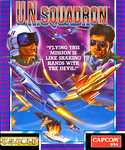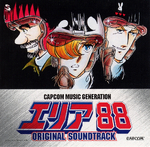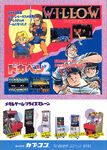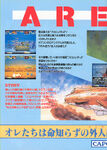(→Story) |
No edit summary |
||
| (27 intermediate revisions by 14 users not shown) | |||
| Line 1: | Line 1: | ||
[[Image:UNSquadronLogo.png|400px|center]] |
[[Image:UNSquadronLogo.png|400px|center]] |
||
| − | '''U.N. Squadron''', |
+ | '''U.N. Squadron''', known as {{Nihongo|'''Area 88'''|エリア88|Eria Hachi-Jū-Hachi}} in Japan, is an arcade game released by [[Capcom]] in 1989 that was ported to the Super Famicom two years later. It is based on [[wikipedia:Kaoru Shintani|Kaoru Shintani]]'s [[wikipedia:Area 88|manga of the same name]] that was later turned into a three part OVA in 1985 by Studio Pierrot, and into a television series in 2004 by Group TAC. The game is a horizontal scrolling shooter in the vein of ''[[w:c:rtype:R-Type|R-Type]]'' and ''[[w:c:gradius:Gradius|Gradius]]''. It was followed by ''[[Carrier Air Wing]]'' in 1990. |
| + | |||
| + | ==Gameplay== |
||
| + | The game is a typical side scrolling shooter, going against the trend of Capcom's other shooters, such as ''[[1942]]'', and ''[[1943: The Battle of Midway]]'', which are vertically scrolling shooters. However, like Capcom's other shooter games, the player has an energy bar that is consumed over the course of a single life as the player sustains damage. This trait is highly uncommon among other comparable arcade-style shooters which normally use a system of reserve lives, where one of which is lost upon a single enemy hit. Before entering a level, the player can purchase special weapons or added defenses in the shop. The player earns money to buy weapons by destroying enemy planes and vehicles during levels and, when the level is finished, any unused weapons are converted back into money. |
||
| + | |||
| + | The player can choose between three mercenary pilots: Shin Kazama, Mickey Simon, and Greg Gates. Each pilot flies a specific plane and has slightly different capabilities. |
||
| + | |||
| + | The game was converted to the Super Nintendo Entertainment System and Super Famicom in 1991. Unlike in the arcade version, each pilot can use a range of planes. All pilots start out with $3000 and the basic F8 Crusader, and can buy other aircraft and weapons as they progress. |
||
| + | |||
| + | == Levels and bosses == |
||
| + | ===Arcade version=== |
||
| + | *01. Frontline base — Missile Tank. |
||
| + | |||
| + | *02. Thunderstorm 1 - Stealth Bomber. |
||
| + | |||
| + | *03. Forest — Forest Fortress. |
||
| + | |||
| + | *04. Desert — Ground Carrier. |
||
| + | |||
| + | *05. Canyon — VTOL Bomber 'Bayson'. |
||
| + | |||
| + | *06. Cave — Missile Launcher. |
||
| + | |||
| + | *07. Airbase/Clouds — Giant Bomber 'Bullhead'. |
||
| + | |||
| + | *08. Ocean — Sub-Boss: Submarine. Boss: Battleship 'Minks'. |
||
| + | |||
| + | *09. Military Base — Arsenal. |
||
| + | |||
| + | *10. Thunderstorm 2 - Project 4 Airborne Fortress. |
||
| + | |||
| + | ===SNES version=== |
||
| + | *01. Frontline Base — Missile Tank. |
||
| + | |||
| + | *02. Thunderstorm — Stealth Bomber. |
||
| + | |||
| + | *03. Forest — Forest Fortress. |
||
| + | |||
| + | *04. Desert — Ground Carrier. |
||
| + | |||
| + | *05. Clouds — Stealth Fighters (Mercenaries). |
||
| + | |||
| + | *06. Ocean 1 - Nuclear Submarine 'Seavet'. |
||
| + | |||
| + | *07. Ocean 2 - Battleship 'Minks'. |
||
| + | |||
| + | *08. Canyon — SR-71 Blackbird. |
||
| + | |||
| + | *09. Cave — Ceiling Machine. |
||
| + | |||
| + | *10. Project 4 Base — Sub-Boss: Giant VTOL aircraft. Boss: Project 4 ship. |
||
| + | |||
| + | == Fleets == |
||
| + | *F-8E Crusader - This is the aircraft that players start with. The ceiling for the Crusader's gun power is average, and the aircraft can only carry three types of special weapons. |
||
| + | |||
| + | *F-20 Tigershark - The cheapest aircraft that can be purchased after completion of the third mission. This aircraft has mediocre weapons capability but it is well suited to both air and ground attack. |
||
| + | |||
| + | *F-14D Tomcat - The F-14D Tomcat is intended primarily for air-to-air combat and carries no real ordnance for attacking ground targets. It is the most maneuverable of all of the aircraft. |
||
| + | |||
| + | *A-10 Thunderbolt II - Intended for ground attack, the A10 fires two shots for every gun burst. One travels forward and the second (slightly weaker) shot travels at a downward 45-degree angle. However, the gun has a low power ceiling. |
||
| + | |||
| + | *YF-23 Stealth Ray - Capable of carrying a wide range of armaments, the YF23's primary attribute is that of stealth. As such, the enemy's guided weapons, such as missiles, will not track the plane. |
||
| + | |||
| + | *F-200 Efreet - The best fighter available in the game. The Efreet has the highest weapon power ceiling, can carry all of the special weapons, can carry more special weapon ammo than any other fighter and is tough to destroy. As such, it is the most expensive fighter available in the game and it is easy to play the whole game without ever having enough money to purchase it (the EF-200 Efreet is nearly identical in appearance to the MIG-31 Firefox from the movie of the same name). |
||
== Story == |
== Story == |
||
| − | Shin Kazama is engaged to his girlfriend, Ryoko, and is on the verge of graduating flight school. He has dreams of becoming an airline pilot for his |
+ | Shin Kazama is engaged to his girlfriend, Ryoko Tsugumo, and is on the verge of graduating flight school. He has dreams of becoming an airline pilot for his fiancée's father's airline corporation, but one night in Paris, his backstabbing false friend Satoru Kanzaki takes him to a bar and has him get drunk enough to trick him into joining the Asran military, where he must serve for 3 years, so that Satoru may take his place as the top pilot of Yamato Airlines and Ryoko's fiancé. And now there's only three ways he can get out: 1. He can serve his three year term, 2. He can buy his way out by earning $1,000,000 from destroying enemies, or 3. He can desert, which is considered a federal crime in Asran. In the fight against Project 4, Shin is joined by two pilots, Mickey Simon and Greg Gates. |
== Characters == |
== Characters == |
||
| − | [[File:Area88_flyer_front.jpg|280px|border|right]] |
+ | [[File:Area88_flyer_front.jpg|280px|border|right|thumb|Flyer (Japanese version).]] |
* '''Shin Kazama''' - The main character of the story. He had dreams of being an airline pilot and being married to his girlfriend Ryoko, but his dreams were crushed when his friend Kanzaki tricked him into joining Area 88. Shin is the fastest character in the game, but also the weakest. |
* '''Shin Kazama''' - The main character of the story. He had dreams of being an airline pilot and being married to his girlfriend Ryoko, but his dreams were crushed when his friend Kanzaki tricked him into joining Area 88. Shin is the fastest character in the game, but also the weakest. |
||
| − | * '''Mickey |
+ | * '''Mickey Simon''' - An American, Mickey is a man Shin befriends at Area 88. Mickey is a Vietnam veteran who abandoned his family after the war, because he was too used to killing people, and he joined Area 88. In the game, Mickey is the in-between character in that he has an even amount of speed and strength. |
| − | * '''Greg Gates''' - Not much is known about Greg. He has a big part in the game being that he's a playable character, but in the anime, while his role is prominent, he wasn't really a big or important character. He is the most powerful in the game however, but also the slowest |
+ | * '''Greg Gates''' - Not much is known about Greg. He has a big part in the game being that he's a playable character, but in the anime, while his role is prominent, he wasn't really a big or important character. He is the most powerful in the game however, but also the slowest. |
| − | * '''Commander Saki''' - The commanding officer at Area 88. He briefs the pilots on their missions and tells them what the payout will be for whoever destroys the main target. |
+ | * '''Commander Saki Vashtal''' - The commanding officer at Area 88. He briefs the pilots on their missions and tells them what the payout will be for whoever destroys the main target. |
* '''McCoy''' - He runs the weapons shop at Area 88 and sells weapons and other items to the pilots. |
* '''McCoy''' - He runs the weapons shop at Area 88 and sells weapons and other items to the pilots. |
||
== Trivia == |
== Trivia == |
||
| + | *[[Mobi-chan]] and [[Yashichi]] appear as items. |
||
| − | *Lieutenant Henry, the player one character from [[Side Arms Hyper Dyne]], appears as a bonus item. |
||
| − | * |
+ | * The TV-series adaptation of ''Area 88'' was released in 2004. Both this version and the 1985 OVA were dubbed into English by ADV Films. In both versions, Shin is played by Chris Patton, who's best known as Sousuke Sagara in the anime ''[[w:c:fullmetalpanic:Full Metal Panic|Full Metal Panic]]''. |
| − | * The manga, |
+ | * The manga, OVA, game and the TV-series each end differently. |
| − | * The bonus stage, where the player(s) has to get the bombs off of a plane carrying innocent civilians, is based on a scene from the 1985 |
+ | * The bonus stage, where the player(s) has to get the bombs off of a plane carrying innocent civilians, is based on a scene from the 1985 OVA. |
| + | |||
| ⚫ | |||
| ⚫ | |||
==Credits== |
==Credits== |
||
===Arcade Version=== |
===Arcade Version=== |
||
'''Planning:''' Mako P, Parazoll Shono, [[Noritaka Funamizu|Poo]]<br />'''Direction:''' [[Yoshiki Okamoto|Kihaji Okamoto]]<br />'''Character Design:''' Manbou Shintan, Gokkun Kuratani, Rekite, Unicorn Mayumi, Traveler Kuramoyan, [[Yukari Kakuta|Holiday Kakkun]], Haru San, Powerful Konomi, Fukumoyan, Femme Hana<br />'''Special Thanks:''' Satochin, Performer Masako, Ozborn, Konitan, Pets Komatsu, Kinta Matsumoto<br />'''Music Composer:''' [[Manami Matsumae|Chan Chakorin]]<br />'''Hard Design:''' Kucchan<br />'''Programming:''' Blbon, Takɐko<br />'''Presented by:''' [[Capcom]] |
'''Planning:''' Mako P, Parazoll Shono, [[Noritaka Funamizu|Poo]]<br />'''Direction:''' [[Yoshiki Okamoto|Kihaji Okamoto]]<br />'''Character Design:''' Manbou Shintan, Gokkun Kuratani, Rekite, Unicorn Mayumi, Traveler Kuramoyan, [[Yukari Kakuta|Holiday Kakkun]], Haru San, Powerful Konomi, Fukumoyan, Femme Hana<br />'''Special Thanks:''' Satochin, Performer Masako, Ozborn, Konitan, Pets Komatsu, Kinta Matsumoto<br />'''Music Composer:''' [[Manami Matsumae|Chan Chakorin]]<br />'''Hard Design:''' Kucchan<br />'''Programming:''' Blbon, Takɐko<br />'''Presented by:''' [[Capcom]] |
||
| − | ===SNES Version [SFX U.N. Squadron Staff] |
+ | ===SNES Version [SFX U.N. Squadron Staff]=== |
'''Planner:''' [[Hisashi Yamamoto|Hisashi "mx5" Yamamoto]]<br />'''Programmer:''' [[Yoshito Ito|Yoshito "Leo" Itoh]], [[Masayuki Akahori|Masayuki "Imo" Akahori]], [[Noriko Aiba|Noriko "Cozy" Kojima]], [[Koji Yoshida|Koji "Yoshilim" Yoshida]], [[Harunobu Imagawa|Harunobu "Img" Imagawa]]<br />'''Object Design:''' Ikki<br />'''Title Design:''' [[Masao Sakurai|Masao "Saksan" Sakurai]], [[Mayumi Tanabe|Mayumi "Tube" Tanabe]]<br />'''Scroll:''' [[Miki Kijima|Miki "Kix" Kijima]], [[Yukari Kakuta|Yukari "Kakkun" Kakuta]], Machako, [[Shizuyo Ukai|Shizuyo "Ucchan" Ukai]], [[Chiharu Akagi|Chiharu "Silkroad" Akagi]]<br />'''Sound Programmer:''' [[Yoshihiro Sakaguchi|Sakaguchi]]<br />'''Sound Design:''' [[Toshio Kajino|Bull]], [[Mari Yamaguchi|Mari]], [[Yasushi Ikeda|Ike-Bomb]]<br />'''English Story:''' [[Scott Maxwell|Scott "Madman" Maxwell]]<br />'''Very Special Thanks:''' [[Kiyomi Kaneko|Kiyomi "Kanekon" Kaneko]], [[Yoshinori Takenaka|"Bamboo"]], U.N. Squadron Arcade Staff<br />'''Special Thanks:''' [[Naoya Tomita|Super Tom-Pon]], Iriko-Chan, Minoru, Hide, Naked, Capcom Staff, and You!!<br />'''Presented by:''' [[Capcom]] |
'''Planner:''' [[Hisashi Yamamoto|Hisashi "mx5" Yamamoto]]<br />'''Programmer:''' [[Yoshito Ito|Yoshito "Leo" Itoh]], [[Masayuki Akahori|Masayuki "Imo" Akahori]], [[Noriko Aiba|Noriko "Cozy" Kojima]], [[Koji Yoshida|Koji "Yoshilim" Yoshida]], [[Harunobu Imagawa|Harunobu "Img" Imagawa]]<br />'''Object Design:''' Ikki<br />'''Title Design:''' [[Masao Sakurai|Masao "Saksan" Sakurai]], [[Mayumi Tanabe|Mayumi "Tube" Tanabe]]<br />'''Scroll:''' [[Miki Kijima|Miki "Kix" Kijima]], [[Yukari Kakuta|Yukari "Kakkun" Kakuta]], Machako, [[Shizuyo Ukai|Shizuyo "Ucchan" Ukai]], [[Chiharu Akagi|Chiharu "Silkroad" Akagi]]<br />'''Sound Programmer:''' [[Yoshihiro Sakaguchi|Sakaguchi]]<br />'''Sound Design:''' [[Toshio Kajino|Bull]], [[Mari Yamaguchi|Mari]], [[Yasushi Ikeda|Ike-Bomb]]<br />'''English Story:''' [[Scott Maxwell|Scott "Madman" Maxwell]]<br />'''Very Special Thanks:''' [[Kiyomi Kaneko|Kiyomi "Kanekon" Kaneko]], [[Yoshinori Takenaka|"Bamboo"]], U.N. Squadron Arcade Staff<br />'''Special Thanks:''' [[Naoya Tomita|Super Tom-Pon]], Iriko-Chan, Minoru, Hide, Naked, Capcom Staff, and You!!<br />'''Presented by:''' [[Capcom]] |
||
| + | *note: Japanese SNES version credits list Masao "Saksan" Sakurai and Mayumi "Tube" Tanabe under Object Design rather than Title Design (the latter heading does not exist in that version). The Object Design credit for Ikki and the English Story credit for Scott "Madman" Maxwell are exclusive to overseas versions. |
||
== Gallery == |
== Gallery == |
||
| − | === |
+ | ===Box Art=== |
| − | <gallery widths=" |
+ | <gallery widths="150" captionalign="left"> |
Image:Area88SuperFamicom.png|''Japan'' Super Famicom |
Image:Area88SuperFamicom.png|''Japan'' Super Famicom |
||
ImageUNSquadronBox.png|''U.S.'' SNES |
ImageUNSquadronBox.png|''U.S.'' SNES |
||
Image:UNSquadronPC.png|''U.S.'' PC |
Image:UNSquadronPC.png|''U.S.'' PC |
||
| + | </gallery> |
||
| ⚫ | |||
| + | |||
| + | ===Merchandise and advertisment=== |
||
| + | <gallery widths="150" captionalign="left"> |
||
| ⚫ | |||
| + | Image:Area_88_Japan_Ad.png|Japanese Ad |
||
| + | Image:Area_88_Gamest.png|Gamest magazine #10 (October 1989) |
||
10000902.jpg|Area 88 flyer Part 2 |
10000902.jpg|Area 88 flyer Part 2 |
||
10000903.jpg |
10000903.jpg |
||
10000904.jpg |
10000904.jpg |
||
</gallery> |
</gallery> |
||
| + | |||
| − | === |
+ | ===Screenshots=== |
<gallery widths="120" captionalign="left"> |
<gallery widths="120" captionalign="left"> |
||
Image:Area88logo.png|''Japan'' Logo |
Image:Area88logo.png|''Japan'' Logo |
||
| Line 57: | Line 129: | ||
Area88008.png |
Area88008.png |
||
Area88010.png |
Area88010.png |
||
| − | Area88_Shin_3.jpg|Picture of Shin from the 1985 anime. |
||
| − | area8820.jpg|Shin and Mickey in the 1985 anime hanging out. |
||
| − | area8890.JPG |
||
| − | area 88-6 (L).jpg |
||
| − | area88_1_19.jpg|Mickey in the 1985 anime. |
||
| − | area88_1_08.jpg|Greg in the 1985 anime after getting shot down, who after getting fixed up goes back out to fight. |
||
| − | area88_1_15.jpg|Saki in the 1985 anime. |
||
| − | area88_1_18.jpg|McCoy in the 1985 anime. |
||
| − | img187.jpg|Picture possibly from Kaoru Shintani's original manga. |
||
</gallery> |
</gallery> |
||
| + | |||
| + | == External Link == |
||
| + | *[[Wikipedia:U.N. Squadron|Wikipedia article]] |
||
| ⚫ | |||
[[Category:Licensed Games]] |
[[Category:Licensed Games]] |
||
| + | [[Category:Shoot 'em up Games]] |
||
[[Category:Shooter Games]] |
[[Category:Shooter Games]] |
||
| ⚫ | |||
[[Category:Arcade Games]] |
[[Category:Arcade Games]] |
||
[[Category:SNES Games]] |
[[Category:SNES Games]] |
||
| + | [[Category:PC Games]] |
||
| + | [[Category:1989 video games]] |
||
| + | [[Category:Comics-based Games]] |
||
Revision as of 04:06, 17 October 2019
U.N. Squadron, known as Area 88 (エリア88 Eria Hachi-Jū-Hachi) in Japan, is an arcade game released by Capcom in 1989 that was ported to the Super Famicom two years later. It is based on Kaoru Shintani's manga of the same name that was later turned into a three part OVA in 1985 by Studio Pierrot, and into a television series in 2004 by Group TAC. The game is a horizontal scrolling shooter in the vein of R-Type and Gradius. It was followed by Carrier Air Wing in 1990.
Gameplay
The game is a typical side scrolling shooter, going against the trend of Capcom's other shooters, such as 1942, and 1943: The Battle of Midway, which are vertically scrolling shooters. However, like Capcom's other shooter games, the player has an energy bar that is consumed over the course of a single life as the player sustains damage. This trait is highly uncommon among other comparable arcade-style shooters which normally use a system of reserve lives, where one of which is lost upon a single enemy hit. Before entering a level, the player can purchase special weapons or added defenses in the shop. The player earns money to buy weapons by destroying enemy planes and vehicles during levels and, when the level is finished, any unused weapons are converted back into money.
The player can choose between three mercenary pilots: Shin Kazama, Mickey Simon, and Greg Gates. Each pilot flies a specific plane and has slightly different capabilities.
The game was converted to the Super Nintendo Entertainment System and Super Famicom in 1991. Unlike in the arcade version, each pilot can use a range of planes. All pilots start out with $3000 and the basic F8 Crusader, and can buy other aircraft and weapons as they progress.
Levels and bosses
Arcade version
- 01. Frontline base — Missile Tank.
- 02. Thunderstorm 1 - Stealth Bomber.
- 03. Forest — Forest Fortress.
- 04. Desert — Ground Carrier.
- 05. Canyon — VTOL Bomber 'Bayson'.
- 06. Cave — Missile Launcher.
- 07. Airbase/Clouds — Giant Bomber 'Bullhead'.
- 08. Ocean — Sub-Boss: Submarine. Boss: Battleship 'Minks'.
- 09. Military Base — Arsenal.
- 10. Thunderstorm 2 - Project 4 Airborne Fortress.
SNES version
- 01. Frontline Base — Missile Tank.
- 02. Thunderstorm — Stealth Bomber.
- 03. Forest — Forest Fortress.
- 04. Desert — Ground Carrier.
- 05. Clouds — Stealth Fighters (Mercenaries).
- 06. Ocean 1 - Nuclear Submarine 'Seavet'.
- 07. Ocean 2 - Battleship 'Minks'.
- 08. Canyon — SR-71 Blackbird.
- 09. Cave — Ceiling Machine.
- 10. Project 4 Base — Sub-Boss: Giant VTOL aircraft. Boss: Project 4 ship.
Fleets
- F-8E Crusader - This is the aircraft that players start with. The ceiling for the Crusader's gun power is average, and the aircraft can only carry three types of special weapons.
- F-20 Tigershark - The cheapest aircraft that can be purchased after completion of the third mission. This aircraft has mediocre weapons capability but it is well suited to both air and ground attack.
- F-14D Tomcat - The F-14D Tomcat is intended primarily for air-to-air combat and carries no real ordnance for attacking ground targets. It is the most maneuverable of all of the aircraft.
- A-10 Thunderbolt II - Intended for ground attack, the A10 fires two shots for every gun burst. One travels forward and the second (slightly weaker) shot travels at a downward 45-degree angle. However, the gun has a low power ceiling.
- YF-23 Stealth Ray - Capable of carrying a wide range of armaments, the YF23's primary attribute is that of stealth. As such, the enemy's guided weapons, such as missiles, will not track the plane.
- F-200 Efreet - The best fighter available in the game. The Efreet has the highest weapon power ceiling, can carry all of the special weapons, can carry more special weapon ammo than any other fighter and is tough to destroy. As such, it is the most expensive fighter available in the game and it is easy to play the whole game without ever having enough money to purchase it (the EF-200 Efreet is nearly identical in appearance to the MIG-31 Firefox from the movie of the same name).
Story
Shin Kazama is engaged to his girlfriend, Ryoko Tsugumo, and is on the verge of graduating flight school. He has dreams of becoming an airline pilot for his fiancée's father's airline corporation, but one night in Paris, his backstabbing false friend Satoru Kanzaki takes him to a bar and has him get drunk enough to trick him into joining the Asran military, where he must serve for 3 years, so that Satoru may take his place as the top pilot of Yamato Airlines and Ryoko's fiancé. And now there's only three ways he can get out: 1. He can serve his three year term, 2. He can buy his way out by earning $1,000,000 from destroying enemies, or 3. He can desert, which is considered a federal crime in Asran. In the fight against Project 4, Shin is joined by two pilots, Mickey Simon and Greg Gates.
Characters
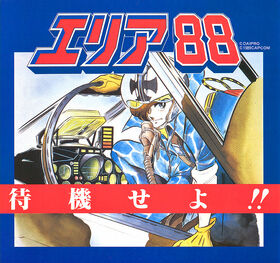
Flyer (Japanese version).
- Shin Kazama - The main character of the story. He had dreams of being an airline pilot and being married to his girlfriend Ryoko, but his dreams were crushed when his friend Kanzaki tricked him into joining Area 88. Shin is the fastest character in the game, but also the weakest.
- Mickey Simon - An American, Mickey is a man Shin befriends at Area 88. Mickey is a Vietnam veteran who abandoned his family after the war, because he was too used to killing people, and he joined Area 88. In the game, Mickey is the in-between character in that he has an even amount of speed and strength.
- Greg Gates - Not much is known about Greg. He has a big part in the game being that he's a playable character, but in the anime, while his role is prominent, he wasn't really a big or important character. He is the most powerful in the game however, but also the slowest.
- Commander Saki Vashtal - The commanding officer at Area 88. He briefs the pilots on their missions and tells them what the payout will be for whoever destroys the main target.
- McCoy - He runs the weapons shop at Area 88 and sells weapons and other items to the pilots.
Trivia
- The TV-series adaptation of Area 88 was released in 2004. Both this version and the 1985 OVA were dubbed into English by ADV Films. In both versions, Shin is played by Chris Patton, who's best known as Sousuke Sagara in the anime Full Metal Panic.
- The manga, OVA, game and the TV-series each end differently.
- The bonus stage, where the player(s) has to get the bombs off of a plane carrying innocent civilians, is based on a scene from the 1985 OVA.
- The other characters from the manga and the two adaptations, including Ryoko and Kanzaki, do not appear anywhere in the game (technically those two in particular do appear, during the bonus stage).
Credits
Arcade Version
Planning: Mako P, Parazoll Shono, Poo
Direction: Kihaji Okamoto
Character Design: Manbou Shintan, Gokkun Kuratani, Rekite, Unicorn Mayumi, Traveler Kuramoyan, Holiday Kakkun, Haru San, Powerful Konomi, Fukumoyan, Femme Hana
Special Thanks: Satochin, Performer Masako, Ozborn, Konitan, Pets Komatsu, Kinta Matsumoto
Music Composer: Chan Chakorin
Hard Design: Kucchan
Programming: Blbon, Takɐko
Presented by: Capcom
SNES Version [SFX U.N. Squadron Staff]
Planner: Hisashi "mx5" Yamamoto
Programmer: Yoshito "Leo" Itoh, Masayuki "Imo" Akahori, Noriko "Cozy" Kojima, Koji "Yoshilim" Yoshida, Harunobu "Img" Imagawa
Object Design: Ikki
Title Design: Masao "Saksan" Sakurai, Mayumi "Tube" Tanabe
Scroll: Miki "Kix" Kijima, Yukari "Kakkun" Kakuta, Machako, Shizuyo "Ucchan" Ukai, Chiharu "Silkroad" Akagi
Sound Programmer: Sakaguchi
Sound Design: Bull, Mari, Ike-Bomb
English Story: Scott "Madman" Maxwell
Very Special Thanks: Kiyomi "Kanekon" Kaneko, "Bamboo", U.N. Squadron Arcade Staff
Special Thanks: Super Tom-Pon, Iriko-Chan, Minoru, Hide, Naked, Capcom Staff, and You!!
Presented by: Capcom
- note: Japanese SNES version credits list Masao "Saksan" Sakurai and Mayumi "Tube" Tanabe under Object Design rather than Title Design (the latter heading does not exist in that version). The Object Design credit for Ikki and the English Story credit for Scott "Madman" Maxwell are exclusive to overseas versions.




